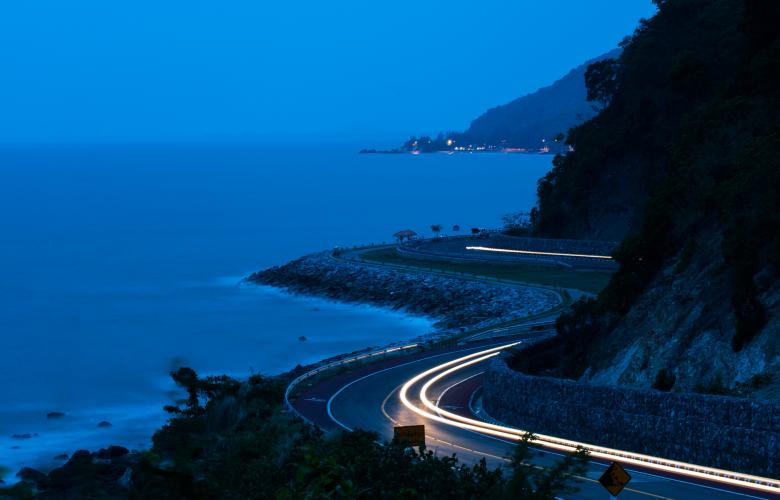East of Bangkok juts a wedge of the country often overlooked in favour of the capital's bright lights or more well-known beaches further south. For travellers desiring a fuller picture of the true Thailand, however, the provinces of Chanthaburi and Trat offer insight into the history, trade and multicultural melange that forms the Kingdom of Thailand.
Meet the king and queen...of fruit
Thais know Chantaburi province as the place where their most favourite fruits come from. The region grows much of the country's divisive durian and marvellous mangosteens, considered the king and queen of fruits respectively. Beyond the fruit orchards mountains, forests, waterfalls, beaches and intriguing historical sites abound.
This region is also notable as a melting pot of cultures thanks to waves of migrations and its position as a disputed border territory. The great warrior-king Taksin was born to a Thai mother and Chinese father, and during his rule of Chanthaburi in the 1700s he encouraged Chinese immigration to the city. In the 1800s, drawn to the rich gem trade, Shan people from Burma began settling in the area soon followed by the French as the great wave of colonialism swept Southeast Asia.
In one of Thailand's many scuffles to avoid the yoke of European rule, Chanthaburi briefly became a French territory and was only returned to Thailand after the cession of vast Cambodian territory, including Angkor Wat, to the French.
Over the centuries, the area has also seen influxes of Vietnamese migrants escaping religious and political persecution. The result is a Thai border province rich in cultural influences, which boasts varied arts and architecture that capture the eye and evoke a spirit of exploration.
Discovering Chantaburi
An excellent place to escape the crowds and other tourists, beaches in Chantaburi are far quieter than those just a couple of hours away, dotted with charming villages and marine reserves. In the surrounding mountains, national parks and waterfalls await discovery. This southeastern province also offers trekking as good as the larger, northern mountain provinces.
Chanthaburi town itself is also worth a visit. As a result of migration, occupation and a prosperous gem trade, the city offers eclectic delights. Stroll through the nightly gem markets where emeralds, sapphires, rubies and more twinkle while exchanging hands. Take a walk along the Chantaboon Waterfront Community, with its laid back, slightly hipster, vibe and enjoy street snacks and people-watching along the restored waterfront buildings which highlight the city’s Chinese, Vietnamese and French colonial influences. Across the river, don't forget to visit the Cathedral of the Immaculate Conception which can be reached via a footbridge.
Must-Sees in Chantaburi
Wat Mangkon Buppharam (Wat Leng Hua Yi) – one of the most beautiful and notable Sino-Buddhist temples in the country.
Laem Sing Beach and fishing villages – Enjoy the tranquil beach or board a boat to discover various fishing communities in the area.
Namtok Phlio National Park – Explore the nature trail which winds through the jungle past ancient, mossy stupas before bathing in crisp pools at the foot of Namtok Phlio waterfall.
Travelling to Trat & beyond
As the southeast trailing edge of Thailand, the province of Trat is just a few hours away from Bangkok and home to gorgeous beaches and islands. Wedged between the Gulf of Thailand to the east and the Cambodian border, which follows the Cardamom Mountains to the west, “The Narrowest Part of Thailand” also forms part of this scenic border province.
Alongside neighbouring Chanthaburi, Trat was annexed by the French and changed hands back and forth several times before finally returning to Thai rule in exchange for vast territories in what is now Cambodia. From rocky coasts to sprawling mangrove forests, Trat is particularly rich in natural resources and here visitors enjoy learning about the different traditional ways of life.
Most travellers to Trat know it as the gateway to gorgeous tropical islands but, while these are certainly a highlight, there is far more to the province. For instance, visitors who do more than just the obligatory stopover can enjoy visits to the Trat Museum housed in a wooden replica of the old provincial town hall. This regional museum documents the area's notable history from the times of Chinese traders to the French occupation and World War II's Battle of Koh Chang. On the outskirts of town, the Ayutthaya-period Wat Buppharam is also well worth a visit.
Nature lovers can enjoy trips along the coast to explore Trat's diverse coastline through a variety of outdoor activities such as paddling through mangroves and birdwatching, learning about the famous edible swiftlet nests treasured by Chinese herbalists, and discovering the many ways these coastal villages make a living from mother nature’s bounty.
Off the coast, Trat’s many islands offer your choice of travel style. For bustling beach bars and bungalows dotting white sand beaches, Koh Chang is a popular tourist hotspot. For a more laid back yet still upscale experience, Koh Kood is reminiscent of the Maldives, with luxury resorts, including the sought-after Soneva Kiri scattered between pristine paradisiacal islands. Rustic Koh Maak is less developed but no less idyllic – the perfect place to truly escape!
Must-Sees in Trat
Mu Ko Chang Marine National Park – Located on Trat's largest island of Koh Chang, enjoy pristine beaches, crystal clear waters and rich marine life.
Trat City Pillar – Not far from the market, the city shrine is ornately decorated in the Sino-Buddhist style.
The Southeast Trat Coast – This narrow strip of land bordering Cambodia is filled with quiet beaches, fishing villages and fruit orchards.
Getting There
Driving from Bangkok to Chantaburi is a relatively pleasant 4-hour journey via Highway No. 34 (Bang Na-Trat) or the Motorway to Chonburi. Take the exit to Highway No. 344 (Ban Bung-Klaeng) and then head into town along Highway No. 3.
Keep driving past Chantaburi about an hour to reach Trat or take advantage of the 1-hour flight between Bangkok and Trat flown by Bangkok Airways three times a day.












